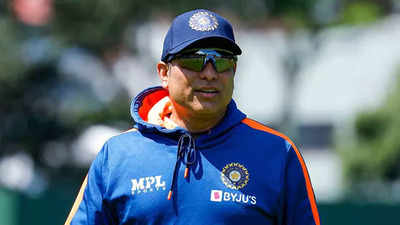
NCA head VVS Laxman talks about how the academy is nurturing talent, managing injuries and more…
BENGALURU: Think VVS Laxman, and you can’t help but reminisce about the supple wristwork, deft touch, and admirable balance that made him such a tough batter to bowl to. Since his retirement in 2012, his cricketing traits have been seen in the many spaces he has explored and excelled at.Primary among them is his role as the head of the National Cricket Academy, which was rechristened BCCI‘s Centre of Excellence (CoE) over the weekend.
The artistic Hyderabadi, who took over the role from Rahul Dravid in December 2021, has had a telling impact on the facility, bringing about holistic development with a focus on youth, education and coaching.
A complete team man who is set for an extension after his contract runs out at the end of the year, Laxman credits his support group for uplifting the standing of the NCA.
In his first media interaction since taking over from Dravid, the 49-year-old outlined the functioning, purpose and outcomes at the CoE.
Excerpts:
On turning administrator
When I took up this role in December 2021, I was very reluctant. But once I embraced this position, it’s been a satisfying and fulfilling experience because you’re dealing with not only the established international stars, but you’re creating the bench strength. To see the amount of talent and potential at our disposal has been very fulfilling. I can say with a lot of confidence, barring a couple of skill sets, we’ve got a lot of players who will make our country proud for the next 10 years. In both men’s and women’s cricket, we’re blessed to have that kind of talent. The idea is to monitor and groom the players so that they realise their potential. I’ve got a wonderful team, which plays a very important role in fulfilling the expectations I have from what we do at the NCA. I think it’s a non-stop grind but satisfying and fulfilling.
On coaching and sharing workload
The methodology of coaching has changed. Now, it’s options that we give, and ultimately the player should feel comfortable acknowledging and accepting that option. If he or she feels something is working, he/she will embrace it and will continue to use it. The whole objective is to give that exposure to the player. Another thing which we have done is monitor the players, both men and women.
On injury management
There is a misconception that deadlines must be met. Sometimes you know you will meet a deadline, but sometimes recovery is delayed, or results aren’t seen. Patience is critical, but recovery can still be delayed. Rishabh Pant, Jasprit Bumrah, Shreyas Iyer, KL Rahul, and Prasidh Krishna worked hard, showed patience, and were rewarded.
On bridging the gaps
When Rahul (Dravid) was the head coach of the Indian team, he used to take care of the contracted players and we at NCA used to take care of the targeted players. That’s how it works. At the domestic level, we have the emerging and under-19 players who we take care of throughout the year. They come for camps and when they go back to their respective state associations, we monitor them. Every NCA coach monitors at least 10 players. We collaborate with the coaches back in the state. Most of those coaches are part of our ecosystem through the summer programmes. It is an open and inclusive way of working. The communication channel is very transparent.
On the importance of bench strength
I’m grateful that the BCCI secretary Jay Shah has allowed my team and me to execute all the programmes and whatever visions we have for the betterment of the players. Everyone talks about the Indian team at the helm. We won the T20 World Cup, which was a great result. But we have dominated in all three formats. That is because there is a huge supply chain, which is a blessing. That is largely because of us giving a lot of importance to first-class cricket.
On the upskill of U-19 players
Every two years, the World Cup is a big occasion for the players. We are going with the intent of winning it, but it is also about embracing the entire process of how you do that. The structure is very good, but we realized from one World Cup to the other that there is always one batch which misses out. The U-19 team is currently playing a series against Australia. Many of the players who might miss out on the next World Cup are part of this series. This gives them exposure to playing at a high level and helps them develop as cricketers.

